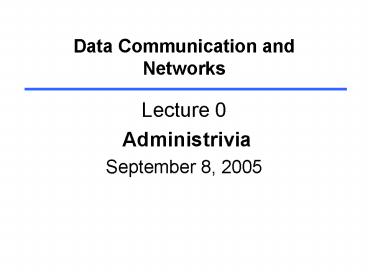Data Communication and Networks PowerPoint PPT Presentation
1 / 12
Title: Data Communication and Networks
1
Data Communication and Networks
- Lecture 0
- Administrivia
- September 8, 2005
2
Adminstrivia
- You must be registered in G22-2262-001 to receive
a grade - How to reach me jconron_at_cs.nyu.edu
- Office hours Thursdays 600 650 (please make
an appointment!)
3
Class Mailing List
- All students should register themselves with the
class list, which is used for all technical
discussions concerning the course. To register,
go to the following web page, and follow the
instructions cs.nyu.edu/mailman/listinfo/g22_226
2_001_fa03 - You will be notified in return that you are a
list participant. Please send all of your
questions to this list (not to the instructor) so
that everyone can participate.
4
Computer Accounts
- Students that do not already have a CIMS Sun
network account should apply for one as follows - Send email to petagna_at_cs.nyu.edu with CIMS
Account Request as the subject. In the body of
the message, type - Name
- Student ID number (assigned NYU SID)
- Department
- Degree Program
- Course numbers of courses you have already
registered for. - Solaris Machines courses1, courses2, courses3
5
Grading
- No Examinations!
- Assignments will require that you write programs
or program fragments and answer some questions
about the assignment. - Assignments will be assigned a fractional weight
a (percentage) of the final grade. - We will grade your programs somewhat
subjectively. You must do more than get the
right answer to earn full credit. For example,
we will look at your program structure and
mechanisms and deduct if you write terribly
inefficient code (poor data structures, excessive
memory use, etc).
6
Grading Schedule
Grades will be given according to the following
schedule A 93 - 100 A- 90 - 92.9 B 87 -
89.9 B 83 - 86.9 B- 80 - 82.9 C 75 -
79.9 C 70 - 74.9 C- 60 - 69.9
7
Rules for Working on Assignments
- All assignments must be done individually (see
Cheating below). - Unless stated otherwise in the assignment, all
writing and coding must be original. - All assignments must be emailed to the
appropriate grader. To avoid problems with
"lost emails" ("the Internet ate my homework")
you should save a copy of your EMAIL (not simply
the assignment itself).
8
Cheating Policy
- You should NOT
- Copy any part of another student's homework
answers. - Allow another student to copy your homework.
- Copy any part of code found in a book, magazine,
the Internet, or other resource. Present the work
of another as your own. If you use the idea of
another in your work, you MUST provide
appropriate attribution (that is, cite the work
and the author). - The penalty for first cheating offense will be a
grade of F for the course.
9
How to hand in AssignmentsLate Assignments
- Homework problems must be submitted by email to
the designated grader. Please include - Your name
- Your SID
- Assignment number (1, 2, )
- Homework may be submitted up to one week late,
but will receive a 10 penalty. - NO credit will be given for ANY assignment
submitted later than one week from the due date.
Since we will go over the assignment in class.
10
Books
- Required texts
- William Stallings, Data Computer Communications
Seventh Edition, Prentice Hall, 2003, ISBN
0131006819 - Recommended texts
- James Kurose and Keith Ross, Computer Networking
A Top-Down Approach Featuring the Internet, 2nd
Edition, Addison Wesley, 2003, ISBN 0201477114 - Douglas Comer, Computer Networks And Internets
with Internet Applications, 3rd Edition, Prentice
Hall, ISBN 0130914495 - Comer, D.E. and Stevens, D.L. Internetworking
with TCP/IP Volume III Client-Server
Programming and Applications, BSD socket version,
Second Edition, Prentice Hall, ISBN
0-13-260969-X, 1996.
11
What We Will Cover
- Protocol Architecture (OSI and Internet)
- Data Structures (FSM, Queues, Ring Buffers)
- Socket Programming
- Data Encoding and Transmission, Error Detection
- Data Link Control
- Performance Issues
- Packet Switching
- Congestion Control and Flow Control Methods
- Internet Protocols (IP, ARP, UDP, TCP)
- Network (packet) Routing Algorithms (OSPF,
Distance Vector) - Multimedia and P2P protocols
12
Questions?

